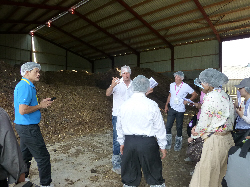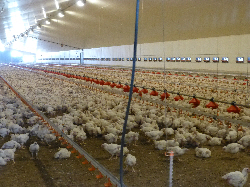



French Farmers Take Novel Approach to Broiler House Heating
It is well known that manure generates heat as it decomposes. A chicken farmer in the Loire Valley region of France has found a way of recycling that energy to heat the broiler house for his next flock. Senior editor, Jackie Linden, explains how the system works and the savings it has generated after visiting the farm.
Jean-Paul and Nadine Chupin and their son, Nicolas, farm 94 hectares - mostly down to grazing and fodder crops for a beef herd of 110 Blonde d'Aquitaine suckler cows and their offspring - in the community of Torfou in the Maine-et-Loire department in western France. They also raise broilers on 3,400 square metres for Doux and destined for the whole-bird export market.
The poultry farm comprises three buildings - one (470 square metres) has tunnel ventilation; a second one covers 1,200 square metres and is a classic poultry house with roof exhaust.
The newest broiler house - the third one on the farm - covers 1,740 square metres and was built in 2012. It too has tunnel ventilation but it is has two unusual features; it was designed as a low-energy building with underfloor heating and the heat source is spent broiler compost.

Features of the Low-energy House
From the exterior, the building looks unremarkable, except for a small additional room, which houses the buffer tank, meters and secondary gas-condensing boiler. Built in 2012, the building's ceiling and walls are well insulated; the ceiling comprises 30-mm polyurethane panel with 200mm of glass wool insulation and the walls are 80mm-thick sandwich panels.
The floor comprises 12-cm thick concrete over the heating pipes. Water enters the house at between 35 and 45°C and run at about 250cm per second through the staggering 14km of pipework that runs under the house, finishing up at 30 to 35°C.

Composting System
The novel part of the whole enterprise is the heat recovery system, which has been running since January 2013. It is based on the composting of spent poultry manure, which takes place in a two-phase process in a neighbouring barn.
The first active phase lasts around six weeks and involves composting the manure - with or without green waste. It is an aerobic fermentation, which requires the material to be sufficiently moist - ideally 40 to 50 per cent dry matter - and to be regularly turned or subjected to forced ventilation. Microbial activity increases the temperature within the heap, which reaches 65 to 70°C within a few days. The heat from this process is 'captured' by a 13-km long network of water pipes that run within the walls and floor of the barn and lead finally to the broiler house via the boiler room.
Regulations require a minimum temperature of fermentation of 50°C for 42 days or 55°C for 15 days to ensure the end product is hygienic. Before fermentation is complete, however, a second active period of six weeks is required - for maturation - which allows the compost to cool down, stabilise and become a good fertiliser.
Costs and Financing
The family invested around €30,000 in the project as well as a great deal of the labour for the construction. They took out a 10-year loan for a total of €322,000. Doux will contribute €25 per tonne of chicken for the first 40 batches. The total cost of the composting barn was €20,000.
The Benefits
Three complete batches of broilers have now been reared in the building. Based on that experience, the Chupin family are pleased with the results. The birds have performed at least as well as those in their other houses and there are signs that there are even fewer problems with foot pad lesions.
There is even distribution of the broilers across the house, which indicates that the conditions are constant over the floor area. And this was noticed even during a period of very cold weather at the start of the year, when the outside temperature dropped to minus 10°C.
Because there is no direct combustion in the building, the atmosphere in the building itself is more pleasant.

Furthermore, the concrete floor of the house is much easier to clean between batches, and residual heat in the floor helps to dry the cleaned house quicker.
Warming up the building for the next batch takes 48 hours, as it does for the older houses with radiant heaters.
Less litter is required to keep the birds comfortable than in the older, conventional houses. The family estimates they need just 500g per square metre in the new house.
Finally, the Chupin family commented that the new installation does require attention to detail in terms of its management and biosecurity and they are still learning how to get the best out of the system. There is, of course, additional work needed to maintain the composting process and ensure that the heat recovery system is functioning as well as possible.
However, the real benefits lie in the energy- and cost-saving features of the new building. The house uses at least 50 per cent less gas than the older houses, which represents a 26 per cent saving on the farm's total gas bill.
Even before the heat recovery system was installed, the new building generated an average of €1.11 per square metre and batch than the older, less well insulated buildings on the farm. Adding in the novel heating system has improved the margin over feed by a further €1.04 per square metre and batch so the overall economic advantage adds up to around €3,750 for each flock through the house.
October 2013








